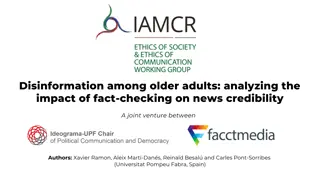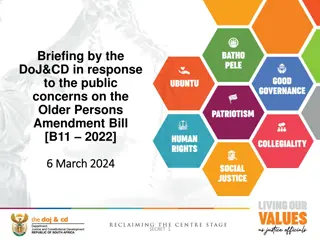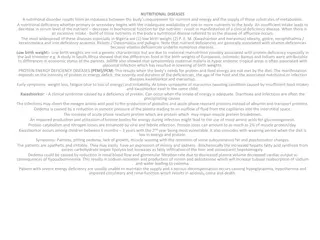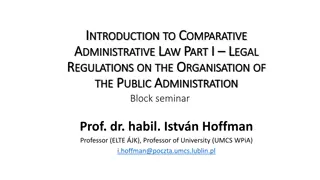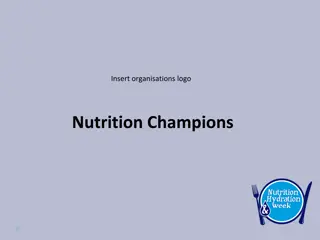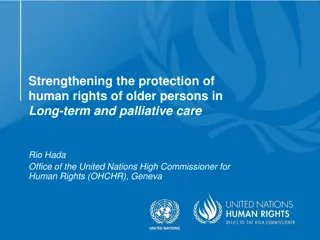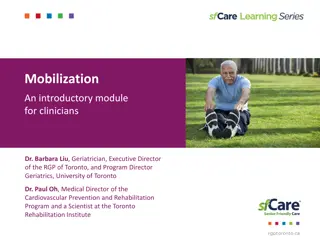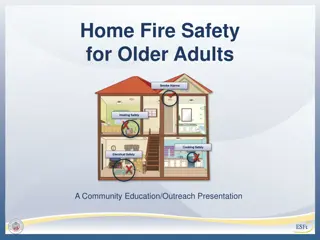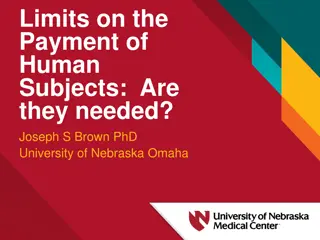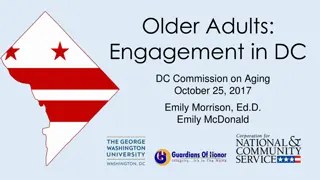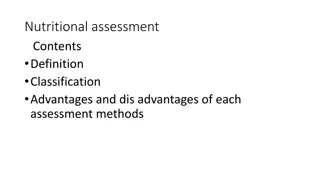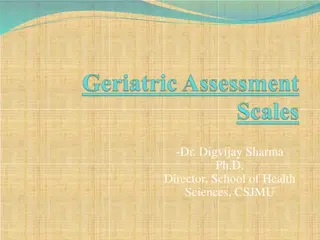Comparison of Nutritional Assessment Tools Among Older Subjects in the Context of Successful Aging
This research project focuses on evaluating various nutritional assessment tools to diagnose malnutrition and related issues among older adults aged 65 and above. The study aims to identify interventions to reduce mortality in malnourished elderly patients, utilizing screening tools, anthropometric measurements, biomarkers, and equations for assessment.
Download Presentation

Please find below an Image/Link to download the presentation.
The content on the website is provided AS IS for your information and personal use only. It may not be sold, licensed, or shared on other websites without obtaining consent from the author.If you encounter any issues during the download, it is possible that the publisher has removed the file from their server.
You are allowed to download the files provided on this website for personal or commercial use, subject to the condition that they are used lawfully. All files are the property of their respective owners.
The content on the website is provided AS IS for your information and personal use only. It may not be sold, licensed, or shared on other websites without obtaining consent from the author.
E N D
Presentation Transcript
Comparison of Nutritional Assessment Tools Among Older Subjects in the Context of Successful Aging Serena Schecaniah Stephenson PhD student Department of Geriatrics Medical University of Lodz Supervisor : Prof. dr hab. n. med. Tomasz Kostka Assistant Supervisor: dr n. med. Bart omiej So tysik
Comprehensive evaluation and objectives: Health and cognitive status for older adults aged 65 and above Assessment tools to diagnose malnutrition and identify related problems for potential intervention Finding ways and solutions to reduce mortality of malnourished elderly patients
Screening tools GERIATRIC ASSESSMENT ANTHROPOMETRIC MEASUREMENTS BIOMARKERS -Mini Mental State Examination (MMSE) -Serum proteins:Albumins (g/dL) - Body mass index (BMI) -Instrumental Activities of Daily Living Scale (IADL) -Arm and calf circumference -Total lymphocytes - Activities of Daily Living (ADL) -Hemoglobin (g/dL) -Total protein (g/dL) -Geriatric Depression Scale (GDS) -Total cholesterol (mg/dL) -Timed up and go test (TUG)
Introduction: Mini Nutritional Assessment (MNA-SF), Nutritional Risk Score (NRS), Comparison of nutritional assessment tools and malnutrition biomarkers with indicators of successful aging. The recommended Screening Tools are as follow: Subjective Global Assessment (SGA), neutrophil to lymphocyte ratio (NLR) lymphocyte to monocyte ratio (LMR) platelet to lymphocyte ratio (PLR) lymphocyte to C-reactive protein ratio (LCR) monocyte to white blood cells ratio (MWR) systemic immune inflammation index (SII) prognostic nutritional index (PNI) C-reactive protein to albumin ratio (CAR)
Materials: Study population -older adults, aged 60 years old and above Hospitalized in the Geriatric Department, Central Veterans Hospital located in Lodz, Poland After screening, 1190 patients (883 women and 307 men) who met the criteria, were enrolled into the analysis. Nagoya J Med Sci. 2022 Feb;84(1):101-110. doi: 10.18999/nagjms.84.1.101. Evaluation of frailty and neutrophil-to-lymphocyte and platelet-to-lymphocyte ratios relationship in elderly people Zeynep Asik 1, Mehmet zen 1 2024 Feb 15;24(1):208. doi: 10.1186/s12885-024-11931-5. Healthy lifestyles, systemic inflammation and breast cancer risk: a mediation analysis Yanyu Zhang # 1, Mengjie Song # 1, Zixuan Yang # 1, Xiaoxi Huang 2, Yuxiang Lin 3 4 5, Haomin Yang 6 7
Methods (equation): NLR= (Neutrophil count (10^9/L))/(Lymphocyte count (10^9/L) ) LMR= Lymphocyte count (10 ^9 /L )/"Monocyte count (10 ^9 /L ) PLR =(Platelet count (10^9/L))/(Lymphocyte count (10^9/L) ) LCR=(Total lymphocyte count (10^9/L))/(C-Reactive protein (mg/L) ) MWR=(Monocyte count(10^9/L))/(Total white blood cell count (10^9/L) ) SII=(platelet count(10^9/L) Neutrophil count (10^9/L))/(Lymphocyte count (10^9/L) ) PNI = [(10 serum albumin (g/dL)) + (0.005 total lymphocyte count)] CAR=(C-Reactive protein(mg/L))/( Albumin (g/dL) )
Results: The mean age of the study population was 81.65 7.57 years. In immunonutritional markers, women had significantly higher LMR, PLR, SII and lower MWR. In tested population, women were significantly older than men. Women presented significantly often the arterial hypertension, lipid disorder, heart failure, osteoarthritis, osteoporosis, incidence of fractures, depression, dementia and urine incontinence. The prevalence of myocardial infarction, gastrointestinal diseases, neoplasms and Parkinson disease was higher in group of men.
Results: LMR and PNI exhibited a negative correlation NLR, LMR, MWR, SII and CAR demonstrated a significant increase with age. PLR and LCR were not correlated with age. 10 600 550 8 500 450 6 400 NLR PNI 350 4 300 250 2 200 0 150 60 65 70 75 80 Age(years) 85 90 95 100 105 60 65 70 75 80 Age(years) 85 90 95 100 105
Factors affecting the studied immunonutritional markers. - bivariate analysis NLR - only age was significantly associated. LMR - age, heart failure and atrial fibrillation. PLR -was negatively related to BMI, presence of atrial fibrillation and male gender. LCR and SII - linked to BMI. MWR- association with age, male gender, diabetes mellitus, atrial fibrillation and dementia. PNI -negatively influenced by age, previous stroke, atrial fibrillation, dementia and positively by lipid disorders and osteoarthritis. CAR, positive impact for age, BMI, diabetes mellitus, atrial fibrillation, and negative for osteoporosis.
Conclusion: Age and BMI - crucial variables influencing the levels of immunonutritional markers. Atrial fibrillation, heart failure and chronic kidney disease, dementia, previous stroke, and osteoporosis - exacerbate the concentrations of the biomarkers. Younger older adults - such as lipid disorders or osteoarthritis, have an opposite effect. The study underscores the practicality of easily accessible biomarkers in evaluating the immunonutritional status of older individuals.
What was accomplished : PUBLICATION IMPACT FACTOR The Relationship between Nutritional Risk and the Most Common Chronic Diseases in Hospitalized Geriatric Population from Central Poland 6.7 Contribution of Physical Activity to the Oxidative and Antioxidant Potential in 60-65-Year-Old Seniors. 7.6 Cardiometabolic Disorders Are Important Correlates of Vulnerability in Hospitalized Older Adults During preparation : 5.9 SUM IF = 20.2 How the immunonutritional markers are associated with most common chronic diseases in geriatric population. Observational study from central Poland. The relationship between serum magnesium levels, cardiometabolic diseases and cognitive performance in hospitalized older adults. Nutrients 2023, 15(7), 1612; https://doi.org/10.3390/nu15071612 Nutrients. 2023 Aug 25;15(17):3716. doi: https://doi.org/10.3390/nu15173716 Antioxidants (Basel) . 2023 May 31;12(6):1200. doi: https://doi.org/10.3390/antiox12061200
Abstract submission and presentation Poster presentation - The Impact Of Chronic Kidney Disease On Vulnerability In Hospitalized Older Subjects 19th Congress of the European Geriatric Medicine Society (19th EuGMS CONGRESS), 2023, 20/09/2023 - 22/09/2023, Helsinki, Finland (https://link.springer.com/article/10.1007/s41999-023-00883-x) Poster presentation- The Relationship between Neutrophil-to-Lymphocyte Ratio and the Most Common Chronic Diseases in Hospitalized Geriatric Population from Central Poland. - 19th Congress of the European Geriatric Medicine Society (19th EuGMS CONGRESS), 2023, 20/09/2023 - 22/09/2023, Helsinki, Finland. https://link.springer.com/article/10.1007/s41999-023-00883-x ) Poster presentation - Low total cholesterol levels are associated with a high risk of malnutrition in older adults-45th ESPEN Congress on Clinical Nutrition & Metabolism (ESPEN 2023), 2023, 11/09/2023 - 14/09/2023, Lyon, France. https://clinicalnutritionespen.com/article/S2405- 4577(23)01367-0/fulltext) Accepted for Verbal Presentation Juvenes Pro Medicina Medical University Of Lodz - Title: Comparative Analysis of Immunonutritional Biomarkers for Predicting In-hospital Mortality in Geriatric Patients; Section: PhD Section (09-05-2024)


